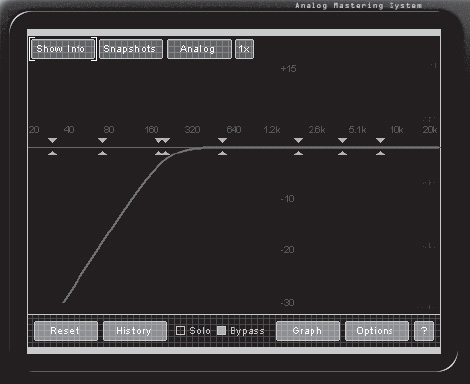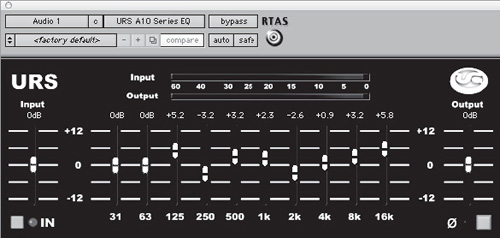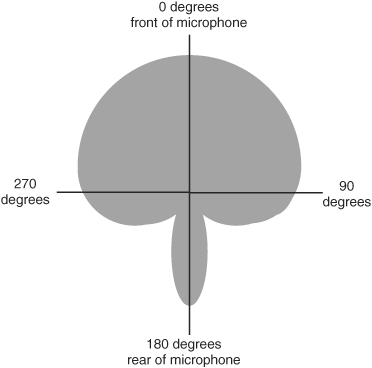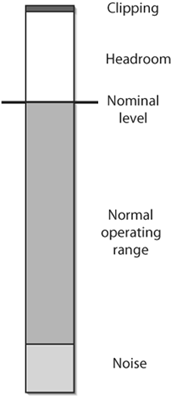Haas effect (a.k.a. precedence effect). A psycho-acoustic phenomenon caused by short delays creating an apparent change in the stereo balance in a signal. If a signal is split to come out of both the left and right channels of a sound system, but one side is delayed, the dry (un-delayed) signal will seem louder. A delay of even a few milliseconds will create this effect; the longer the delay, the more intense the effect.
half damper. A piano performance technique, originally for acoustic pianos, in which the sustain pedal is pressed partway down, which partially raises the dampers off the strings. Some digital pianos are able to emulate this effect.
half duplex. A device that supports input and output, but only in one direction at a time.
half normal. A type of normal connection in a patch bay in which a signal fed into the top back jack of the bay will automatically be connected to the bottom back jack of the bay. Plugging a cable into the front top jack does not break the “normal” connection to the bottom back; instead, it splits the signal to feed whatever is plugged into the front and continues to feed the normal connection out of the bottom back row, creating a Y. Plugging into the front bottom jack does break the “normal” connection to the bottom rear jack, allowing the signal to be rerouted. ![]() See also normal.
See also normal.
half space. A sound source, such as a speaker, located against a surface, such as a wall, is said to be in half space (versus being in free space, where sound is able to travel in any direction). Half-space placement of a speaker or other sound source results in a 3-dB level increase (mainly in the low frequencies) over free-space placement. ![]() See also free space, quarter space, eighth space.
See also free space, quarter space, eighth space.
half-track. An analog tape recorder head format in which two channels cover the entire width of the tape.
hall reverb. A type of digital reverb preset that is intended to re-create the ambience of a large hall.
hammer action. A type of key action that incorporates the same type of mechanical hammers as are found on a real piano, in order to give the player the feel of playing an acoustic piano. Hammer-action keybeds are generally found on 88-note keyboards.
handling noise. Noise created in a microphone by physical handling, movement, vibration, and shock. Some microphones have internal shockmounts to reduce or eliminate this problem, particularly models intended for handheld use onstage.
handshake. A signal that verifies connection and communication between two devices or programs.
hangover. In addition to the obvious definition, hangover is the tendency of a speaker cone to keep moving after signal from its amplifier stops or after a transient passes. Damping factor is used to control hangover.
hard disk. Technically, the spinning oxide-coated Mylar disk inside a hard drive that is used to store data. In common use, hard disk refers to the enclosure, drive electronics and mechanism, and the disk itself. ![]() See also hard drive.
See also hard drive.
hard drive. A unit containing an enclosure, drive and interfacing electronics, motors and other mechanical elements, and an oxide-coated disk, all used to create a device that can store and read large amounts of computer data at high speed.
hard knee. The mode of operation of most compressors, which immediately start attenuating the signal according to the ratio as soon as the signal crosses the threshold (see Figure H.1). ![]() See also soft knee.
See also soft knee.

Figure H.1. Most compressors use hard-knee operation, in which gain reduction is applied as soon as the signal crosses the threshold.
hard reset. A command or function that returns a device to its initial power-on state—as it was when the power was first turned on or when the device left the factory. All memory is cleared, and all settings and parameters are returned to their default states.
hardware. A device or item made of actual physical components and parts.
hardware bypass. ![]() See true bypass.
See true bypass.
hardwired. 1. Connected with physical cables and wires. 2. A setting, routing, or parameter that is permanently set and cannot be changed by the user.
harmonic. A component frequency in a waveform occurring at an integer multiple of the fundamental’s frequency. (Technically, the fundamental is also a harmonic.) ![]() See also harmonic series, fundamental, overtone.
See also harmonic series, fundamental, overtone.
harmonic distortion. Distortion added to a signal in the form of additional harmonics or changes in the relative levels of the original sound’s harmonics.
harmonic series. One of a series of frequencies including and related to the fundamental frequency of a tone. The harmonic series consist of integer multiples (1×, 2×, 3×, 4×, and so on) of the fundamental. For example, the harmonics for a 1,000-Hz tone are 1,000 Hz, 2,000 Hz, 3,000 Hz, 4,000 Hz, and so on.
Harmonizer (a.k.a. pitch shifter). Harmonizer is a term trademarked by Eventide and used in association with the company’s various models of pitch-changing processors.
harmony generator. A device, plug-in, or program that changes the pitch of a signal to create harmonies that can be blended with the original signal to create chords or harmonized melodic lines.
HDCD. High-Definition Compatible Digital. A type of audio compact disc that supports 20-bit resolution. A compatible drive is required to play back the audio with full resolution. HDCD discs are backward compatible with regular CD players, though only with 16-bit resolution. HDCD has not seen wide acceptance in the marketplace.
HDMI. High-Definition Multimedia Interface. An all-digital connection protocol that carries both audio and video signals, allowing single-cable connections. Some computer monitors offer HDMI connections.
head. 1. A transducer that reads the magnetism on a tape or hard disk and converts it into electrical signals, converts electrical signals to magnetism in order to store them to tape or disk, or uses magnetism to “erase” stored data or signals on a tape or disk. 2. An instrument amplifier that is in a separate enclosure from its complementary speaker cabinet. 3. The beginning of a tape (as opposed to the end or tail).
head crash. A disk failure in which a head contacts the moving platter surface, damaging the magnetic surface and causing permanent data loss.
header. A part of a file that contains information about that file, such as creation and update dates, file size, sample rate, resolution, number of channels, and more.
head gap. The distance between the north and south poles of the magnet in a tape recorder head.
head stack. The part of a tape recorder that contains the tape heads.
headphone amp. An amplifier designed and optimized for raising the level of a signal from line level to sufficient power to drive headphones. Some headphone amps have multiple channels, each with their own input and output so that each musician in a group can be fed his or her own mix with its own volume level.
headphone output. An output, usually a 1/8-inch or 1/4-inch TRS jack, that is intended to drive headphones.
headphones (a.k.a. cans, phones). A type of monitoring device featuring a cup or pad that contains small drivers for each ear. The ear cups are joined by a headband that holds them in position on the listener’s head. There are two types: open (lets sound in and out of the headphones) and closed (seals the sound into the headphones and isolates the listener from external sound). There are also two types of physical designs: circumaural, in which the ear cups encircle the ear and the cup rests on the side of the listener’s head, and supraaural, which features pads that rest on the listener’s ears. Headphones typically have 1/8-inch or 1/4-inch TRS jacks for connecting to a headphone amplifier or headphone output.
headroom. Dynamic range available between the normal or nominal operating level and the onset of clipping or distortion. Headroom is important in a variety of situations, such as when dealing with combining signals together when mixing (which adds level) and for cleanly handling transients and other signals that have wide, fast level changes. See Figure H.2.
heat. The transfer of energy due to a temperature difference. Heat is the enemy of electronic equipment.
heat sink. A device that is designed to dissipate heat from sensitive electronic components that are not able to dissipate heat quickly enough on their own.
Helmholtz absorber. An acoustic device consisting of a resonator that vibrates in response to sound waves at a particular frequency or range of frequencies. In practice, a Helmholtz absorber is a box enclosing a volume of air, with a series of slits or holes in one surface. Air motion due to sound waves causes the absorber to resonate in much the same way as blowing across the opening of a soda bottle creates a tone. The energy required to cause the absorber to resonate reduces the sound energy in the room. Named for Hermann von Helmholtz, a German physicist and physiologist who wrote the book On the Sensations of Tone.
Helmholtz device. ![]() See Helmholtz absorber.
See Helmholtz absorber.
Helmholtz resonator. ![]() See Helmholtz absorber.
See Helmholtz absorber.
hertz (a.k.a. Hz, cycles per second). The number of vibrations or complete cycles of a sound wave occurring within a second. Named for Heinrich Hertz, a late-19th-century physicist who first investigated and artificially produced radio waves.
hexadecimal (a.k.a. hex). A number system that uses 16 as its base, rather than 10, as in our standard system. The hexadecimal numbering system uses 16 values: 0, 1, 2, 3, 4, 5, 6, 7, 8, 9, A, B, C, D, E, and F, which represent the decimal values 0 through 15. Hexadecimal provides a convenient way to represent binary numbers, as each hexadecimal digit can represent four bits (also know as a nibble), or two hex digits can represent a full 8-bit byte. See Table H.1; to represent longer binary numbers, multiple hexadecimal digits are used, one digit for each four bits. For example, the binary number 0010110110001110 would be split into groups of four bits (0010 1101 1000 1110) and represented as 2D8E in hexadecimal. Hexadecimal numbers are occasionally encountered by users in the deepest levels of MIDI programming and in MIDI implementation charts.
Table H.1. Decimal, Binary, and Hexadecimal Numbering
Decimal | Binary | Hexadecimal |
|---|---|---|
0 | 0000 | 0 |
1 | 0001 | 1 |
2 | 0010 | 2 |
3 | 0011 | 3 |
4 | 0100 | 4 |
5 | 0101 | 5 |
6 | 0110 | 6 |
7 | 0111 | 7 |
8 | 1000 | 8 |
9 | 1001 | 9 |
10 | 1010 | A |
11 | 1011 | B |
12 | 1100 | C |
13 | 1101 | D |
14 | 1110 | E |
15 | 1111 | F |
hexaphonic pickup. A type of guitar pickup made of six separate smaller pickups, one for each string. Hexaphonic pickups are most commonly seen in MIDI guitar conversion systems, where each string’s motion can be converted to MIDI data independently and is assigned to its own MIDI channel. In a few cases, hexaphonic pickups are used to produce a separate analog instrument-level output for each string so that each string’s signal can be processed and amplified separately, allowing unique panning and sonic possibilities.
HF. ![]() See high frequency.
See high frequency.
HFS. Hierarchical File System, a.k.a. Mac OS Standard. A hard drive file system developed for Macintosh computers in 1986. Files up to two gigabytes were supported, with file names up to 31 characters long and a maximum of 65,535 files per volume.
HFS+. Hierarchical File System Plus, a.k.a. Mac OS Extended. An updated version of Apple’s HFS, which allows file names up to 255 characters long, files sizes over two gigabytes, and unlimited files per volume.
hierarchical menu. A menu structure consisting of directories or menus that branch off from the main menu and continue branching to various levels. See Figure H.3.
high-cut filter (a.k.a. low-pass filter). A filter that reduces the frequencies above the cutoff frequency and allows frequencies below the cutoff frequency to pass through unchanged.
high definition. An increased definition or resolution compared to “normal.” In audio terms, this would typically mean 20- or 24-bit resolution versus normal 16-bit resolution. In common use, higher sample rates (above the normal 44.1 or 48 kHz) are included when discussing high definition.
high end. 1. A term used to refer to high frequencies and the treble range of the frequency spectrum. 2. A term used to refer to expensive pieces of gear.
high frequency. A term used to refer to the highest frequencies in the audio spectrum; there is no specific high-frequency range, though in general, the range of 6,000 Hz to 20,000 Hz would qualify.
high impedance. An impedance above 600 ohms, typically several thousand ohms or more. This term is most often encountered with instrument inputs, such as those for guitar or bass, and with direct boxes. ![]() See also impedance.
See also impedance.
high-pass filter (a.k.a. low-cut filter). A filter that passes frequencies above a certain point and reduces the level of frequencies below that point. High-pass filters are used to reduce rumble, as well as boominess caused by excessive low-frequency levels. See Figure H.4.

Figure H.4. A high-pass filter allows frequencies over the cutoff frequency to pass unaffected, while reducing the level of frequencies below the cutoff frequency.
High Sierra Format (a.k.a. HSF). A CD-ROM standard created by a group of 12 computer hardware manufacturers known as the High Sierra Group because they held their meetings at the High Sierra Hotel and Casino in Lake Tahoe, CA. The High Sierra Format was developed in 1986 based on the Yellow Book specification and later became the standard upon which the ISO 9660 format was based.
High-Z. ![]() See high impedance.
See high impedance.
histogram. Technically, a bar graph. This term is sometimes used by manufacturers to refer to LCD or LED meters resembling bar graphs that display frequency or amplitude information over time. See Figure H.5.

Figure H.5. Because they resemble bar graphs, certain types of meters are referred to as histograms. In this example, there is a histogram (to the right of the left/right input meters) of the waveform peaks in the input signal.
Hi-Z. ![]() See high impedance.
See high impedance.
hold. A parameter on a noise gate that sets the amount of time the gate remains open after the input signal drops below the threshold. Carefully setting the hold parameter prevents the gate from chopping off the quiet decay portion of a sound or reverb tail.
horn loaded. A driver that is attached to a horn or that is mounted into a horn-shaped cabinet in order to control dispersion or to increase throw (projection) of sound over longer distances.
host. 1. The computer on which a program is running or to which a peripheral device is attached. 2. A program, such as a DAW, in which plug-ins are running.
host-based. 1. Software that runs on a computer without the need for any additional DSP or other hardware. ![]() See also native. 2. A plug-in that operates within another piece of software (the host).
See also native. 2. A plug-in that operates within another piece of software (the host).
host computer. ![]() See host.
See host.
hot-pluggable. A device that can be safely connected to, or disconnected from, a system while the power is turned on.
hot spot. A position in a room where there is a boost at a particular frequency or range of frequencies.
hot-swappable. 1. ![]() See hot-pluggable. 2. A type of media that can be safely removed from a drive chassis (such as a removable hard drive) without danger of losing data.
See hot-pluggable. 2. A type of media that can be safely removed from a drive chassis (such as a removable hard drive) without danger of losing data.
house sync. ![]() See blackburst.
See blackburst.
HTDM. Host TDM or Host Time Division Multiplexing. A hybrid of native processing (which runs on the host computer’s CPU) and DSP-based TDM processing developed by Digidesign that allowed native plug-ins to appear as TDM plug-ins to a Pro Tools system. ![]() See also TDM.
See also TDM.
hub. 1. The center part of a tape reel, which attaches to the tape recorder. The tape is wound around the hub and held in place by flanges, the sides of the reel, which attach to the hub. 2. A device for connecting multiple devices to a single computer port, such as a USB hub, which allows several USB devices to connect to a single USB port.
HUI. Human User Interface. The HUI was a control surface with knobs, faders, and switches like a mixer (though it was a control surface and does not pass sound itself) that was developed and manufactured by Mackie Designs. The HUI had a generic protocol that was compatible with a number of DAWs. Subsequent control surfaces from Mackie and other companies have offered support for the HUI protocol, which has become a de facto standard.
hum. A type of low-frequency noise that is typically caused by grounding problems or EMI. Hum of this type generally is centered at 60 Hz based on the AC power frequency—and thus called 60-cycle hum—with harmonics sometimes audible at 120 Hz, 180 Hz, and so on. In Europe and some other areas, the frequency of AC power is 50 Hz, resulting in hum at 50 Hz with harmonics at 100 Hz, 150 Hz, 200 Hz, and so on.
humanize. A function found in MIDI sequencers that attempts to manipulate MIDI notes (especially those that have been heavily quantized or that have been entered in step time or to a grid) to make them seem more natural and “human.” Typically, this is accomplished by adding random variations to note timing, velocity, duration, and other parameters. See Figure H.6.

Figure H.6. Many DAWs and sequencers have a “humanize” function that can randomize a number of parameters by small amounts to make a track seem more natural.
humbucking coil. A coil of wire that is intended to pick up noise, which can be inverted in polarity, and then used to cancel the noise in a desired signal path.
HX Pro. A system for analog tape developed by Dolby Laboratories that increased high-frequency headroom, reducing the tendency of loud high frequencies to erase their own signal or to distort due to oversaturation.
HVAC. Heating, Ventilation, and Air Conditioning. The ducts and climate control equipment in a building. In recording studios, HVAC must be installed and managed carefully in order to minimize the noise it creates.
hybrid. Something that combines more than one technique or technology. A piece of gear might be a hybrid of tube and solid-state technology, or digital and analog, or various other things.
hybrid synthesizer. A synthesizer that combines two or more types of synthesis to create sounds.
hyperacusis. A hearing problem caused by damage to the inner ear, where quiet and moderate-level sounds seem too loud. Around 40% of people with tinnitus also suffer from hyperacusia.
hypercardioid. A microphone polar pattern that is more directional than cardioid and that has a small rear lobe (see Figure H.7). There are two null points, typically around 150 and 210 degrees. ![]() See also cardioid, polar pattern.
See also cardioid, polar pattern.

Figure H.7. The hypercardioid microphone polar pattern is more directional than the cardioid pattern and has two nulls, creating a lobe to the rear of the microphone.
hysteresis. 1. Literally, to lag behind. The term is used to describe the tendency of a change in magnetism to lag behind the application and removal of a magnetic field, the response to an input signal being different than the response to an output signal, the action of a gate, and other things. 2. A control found in some noise gates that sets a second threshold for closing the gate. The gate opens when the signal crosses the threshold setting, but does not close until it crosses the hysteresis setting. This allows better control over how the gate operates and helps prevent desired signals from being chopped off when the gate closes.
Hz. ![]() See hertz.
See hertz.


